The 2N series, created by RETMA, the Radio Electronics & Television Manufacturers Association which in 1957 became the EIA (Electronic Industries Association), was the first series of transistors that contained devices from many vendors using a common numbering system. It was used for a good number of years and contains thousands of types. Although each type number was assigned to one manufacturer, many types were 'second-sourced' by one or more vendors. The 2N21 is the lowest-numbered device in the series: the range 2N1 to 2N20 was not used, although I have one data book that mentions 2N18 and 2N19 by Fivre, an Italian manufacturer that I have never encountered. The classic source for data on early members of this series is the General Electric 'Transistor Manual', which was issued annually from 1956, the first edition already having devices up to 2N293. However, GE exclude some devices from certain manufacturers, notably Western Electric, Transitron, National Union and Westinghouse.
This page shows 2N types up to about 2N200, which is an approximate limit of interesting collectable types except for a few higher-numbered ones that are special in some way. The page is graphically intensive and may take some time to load on a slow Internet connection. All types shown are germanium devices unless otherwise noted.
I do not possess all the transistors below, in fact I am seeking many of them. I am indebted to Terry Hoskings, Bob McGarrah and Kail Secrest for a number of the images. It is noted in the text where I am seeking examples of any particular type: if you have some for sale or exchange, please
.
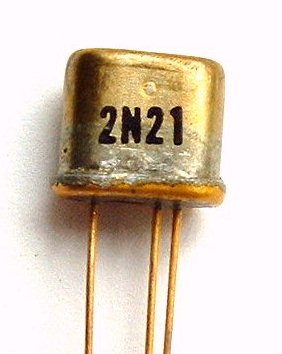
The 2N21 from Western Electric is the lowest-numbered device in the series but not the oldest type, it dates from 1955, two years later than several other 2N types. Despite using single-ended packaging, it is a N-type point-contact transistor for use as an AF amplifier.
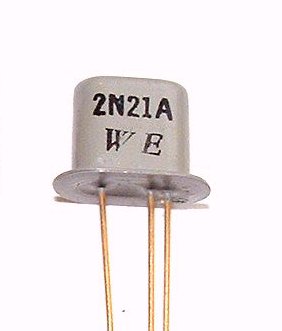
The 2N21A is a later version of the 2N21 in improved packaging.
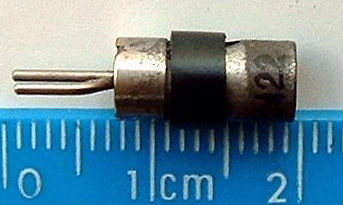
The N-type point-contact transistor 2N22 from 1954 uses the Western Electric 'outline number 1' cartridge case. This case plugs into a small socket, and was used by many point-contact types from Bell/WeCo and other manufacturers. The transistor was used as a low-power switch.
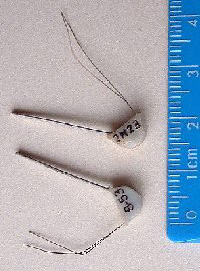
The Western Electric N-type point-contact transistor 2N23 from 1953 uses the 'outline number 2' bead case. This case is a plastic semidisk encapsulating the germanium die, which is fixed to the metal strip forming the base connection. The two thin wires are the emitter and collector and connect to the internal point contacts. The transistor was used as a low-power switch.
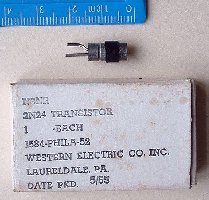
The 2N24 N-type point-contact transistor from 1953 uses the Western Electric 'outline number 1' cartridge case. It was used as a low-power amplifier oscillator. See Jack Ward's site for more details on this device.
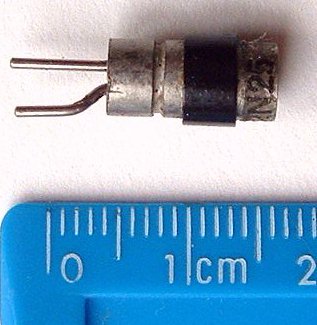
The 2N25 N-type point-contact transistor from 1954 also uses the Western Electric 'outline number 1' cartridge case. It was used as a low-power AF amplifier.
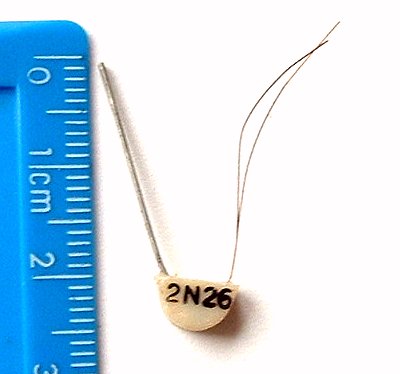
The Western Electric 2N26 from 1954 is the only 2N type other than 2N23 to use the 'outline number 2' bead case. The transistor was used as a low-power switch.
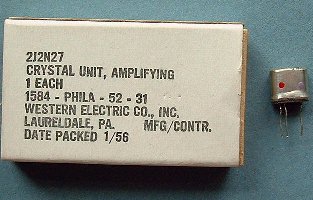
The 2N27 from 1954 is the first in a trio of Western Electric (and possibly also CBS) grown-junction transistors, and in common with nearly all grown-junction types they have NPN polarity. Some examples come in individual cartons as shown and can be identified by the coloured paint dots using the standard 'resistor code'': red is two and purple is seven. Later examples are printed '2N27'. It was used as a low-power AF amplifier. See Jack Ward's site for more details on this trio of transistors.
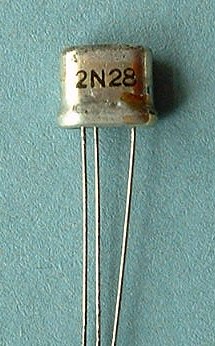
The 2N28 is the second in this NPN grown-junction trio. Again some examples have paint dots and some have the type number printed on them, as in this example. It was used as a low-power AF amplifier.
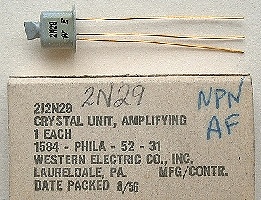
The 2N29 is the third in the trio. The example shown is dated August 1956 and uses a more sophisticated package than the crudely soldered 2N27 and 2N28 shown above. However, there is no suffix 'A' as was done for the 2N21.
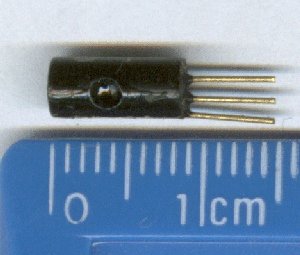
The 2N30 is listed in the GE Transistor Manual, which states that it is obsolete, and is the 'old G11'. This is a GE point-contact transistor in a unique small cartridge package, which is shown above. I wish to buy examples of this device.

The 2N31 is listed in the GE Transistor Manual first edition, which states that it is obsolete, and is the 'old G11A'. This is an improved version of the GE G11 point-contact transistor in a unique small cartridge package as shown above. I am seeking examples of this device.
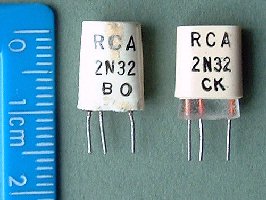
The 2N32 is an RCA point-contact transistor in a single-ended package that has all leads emerging from the same end. The leads were anchored in a small glass block, allowing the transistor to be constructed above it, and then the whole upper part was sealed in a white epoxy block. Two different shapes of this transistor exist, one flatter than the other and with the glass anchor block visible. The transistor was used as a low-power switch. I wish to buy examples of this device made by Sylvania, and also examples with an 'A' suffix.
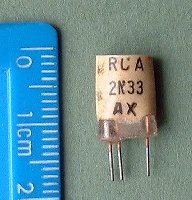
The 2N33 is another RCA point-contact transistor in the same two package shapes as the 2N32. The transistor was used as an RF mixer or oscillator. I wish to buy examples of this device made by any other manufacturer. I do possess some mysterious unbranded 2N33A devices in a more modern encapsulation. See Jack Ward's site for more details on this device.
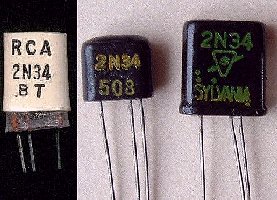
The 2N34 is a PNP junction transistor for use as a low-power AF amplifier. It was the first in the series to be made by many manufacturers including RCA, Sylvania, Transitron, and ETCo (Electronic Transistors Corporation).
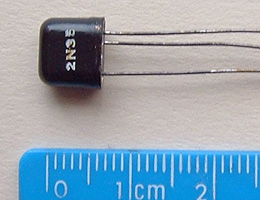
The 2N35, assigned to Sylvania, was also made by other manufacturers: RCA, General Electric, General Transistor, and ETCo. It is a low-power NPN AF type intended for the hobbyist market. See Jack Ward's site for more details on this device.
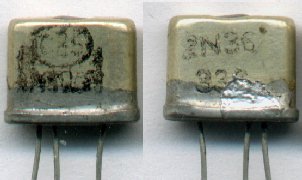
CBS type 2N36 was also made by Transitron, and possibly by ETCo. It is a PNP high-gain type. The image shows a rare early form in an elongated metal can. It is more usual to find examples in a cylindrical can with a white plastic sleeve, as per the 2N37 and 2N38 which follow. I am seeking examples of this device.

CBS type 2N37 was also made by Transitron, and possibly by ETCo. It is a PNP medium-gain type. I wish to buy examples of this device.
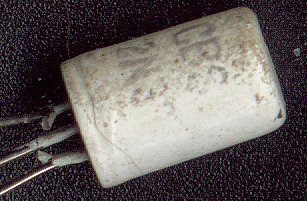
CBS types 2N38 and 2N38A were also made by Transitron, General Transistor and possibly by ETCo. They are PNP general-purpose AF types. I wish to buy examples of these devices.
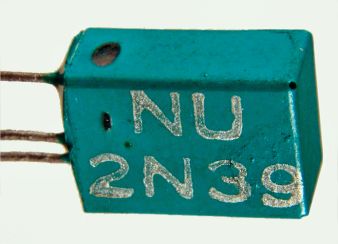
Types 2N39 and 2N40 PNP-fused transistors are amongst the very few made by National Union Electric, as well as General Transistor. They were designed for general purpose AF amplifier applications. I wish to buy examples of these devices.
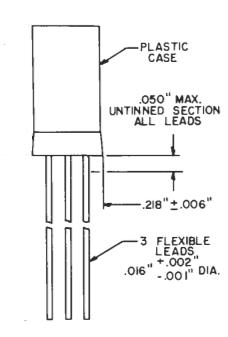
RCA type 2N41 is a PNP AF general-purpose type. I wish to buy examples of this device.
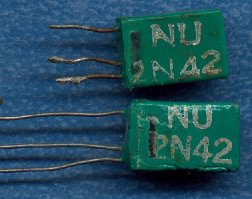
The type 2N42 PNP-fused transistor is one of the very few made by National Union Electric, as well as General Transistor. It was designed for general purpose AF amplifier applications. I wish to buy examples of this device.
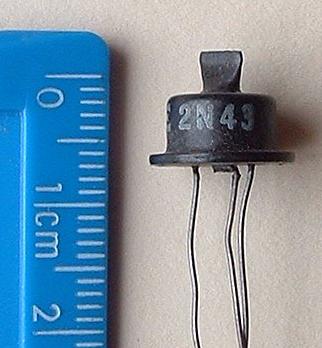
General Electric types 2N43 and 2N43A are alloy-junction PNP units intended for high-gain, low to medium power AF applications. They were also made by several other manufacturers. The package that this and a number of other GE types use is known as the 'lady top hat'. Some versions have an evacuation port on top, as shown here, others do not. The A suffix denotes the military specification version, with tightly controlled parameters. See Jack Ward's site for more details on this device and the 2N44 and 2N45.
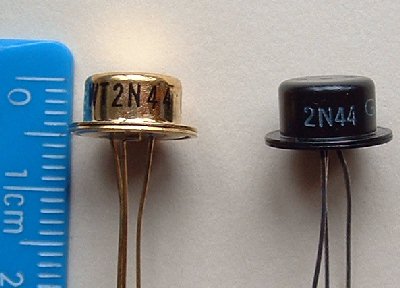
General Electric type 2N44 is an alloy-junction PNP unit intended for medium-gain, low to medium power AF applications. It was also made by several other manufacturers. The gold-plated one on the left appears to bear the branding 'WT' - I'm not sure if this is Westinghouse, please contact me if you know.
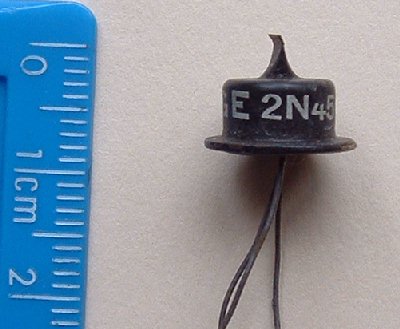
General Electric type 2N45 is an alloy-junction PNP unit intended for medium-gain, low to medium power AF applications. It was also made by several other manufacturers.

RCA type 2N46 is another PNP type designed for general purpose AF amplifier applications. I wish to buy examples of this device.
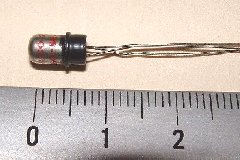
Philco types 2N47, 2N48 and 2N49 use their 'cigar tube' case. They are alloy-junction high-gain low-noise PNP devices for use in hearing aids. I wish to buy examples of these devices.
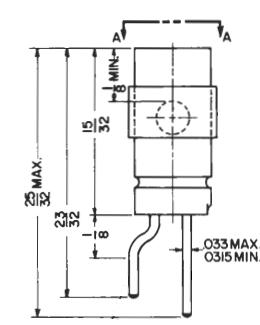
The Clevite types 2N50, 2N51, 2N52 and 2N53 are N-type point-contact transistors used as oscillators and switches. I wish to buy examples of these devices.
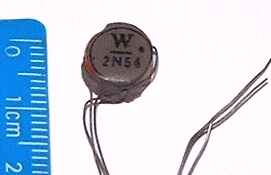
The Westinghouse PNP-fused 2N54, 2N55 and 2N56 are a gain-selected trio of low-power AF types. I wish to buy examples of these devices.
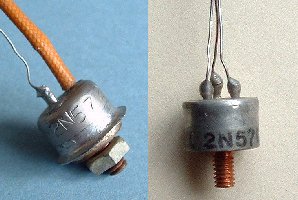
The Honeywell 2N57 was one of the first true power transistors available commercially. It has a power dissipation of 20 Watts and uses a unique case style. Early examples have a bell shaped case as shown and are unbranded. Later ones have a cylindrical case printed HONEYWELL.
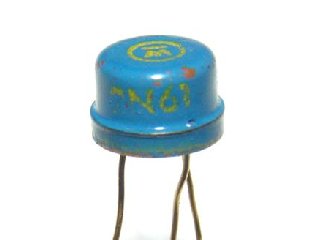
Westinghouse PNP types 2N58 to 2N61 are designed for general purpose AF amplifier applications. I wish to buy examples of these devices.

Philco 2N62 is another general purpose AF amplifier type in the typical Philco 'cigar tube' case. I wish to buy examples of this device.
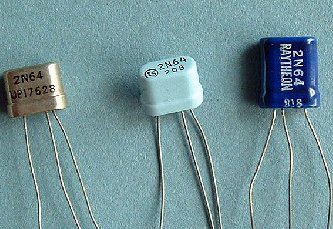
2N63, 2N64 and 2N65 are a trio of gain-banded PNP AF types originated by Raytheon, the gain increasing from 2N63 through to 2N65. These were also made by other manufacturers, notably Tung-Sol in the 'baby blue' case shown.
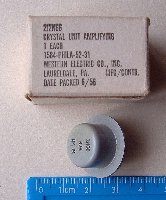
The Western Electric 2N66 is a high-power type for high-current switching and RF amplification.
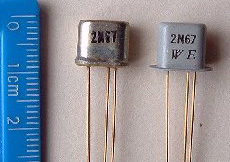
The Western Electric 2N67 is a point-contact high-speed switching transistor, despite its modern packaging. The image shows an old hand-soldered example and a later one - unlike the 2N21 this was not given an 'A' suffix.
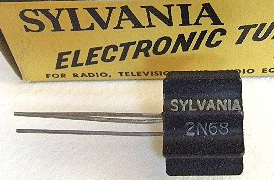
The Sylvania 2N68 is an early PNP-alloyed high-current low-voltage type with a large octagonal finned heatsink. See Jack Ward's site for more details on this device.
The 2N69 is a very obscure type, manufactured by RCA but sometimes ascribed to other vendors in early data books. I wish to buy examples of this device.
The part number 2N70 seems to have never been used, although it may be assigned to a manufacturer. If you know anything about it please contact me. I am seeking examples of this device.
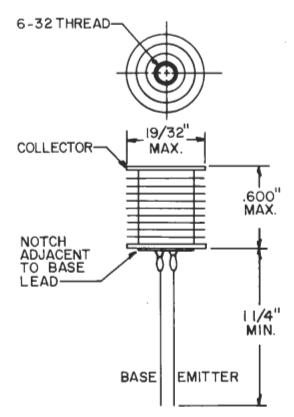
The Westinghouse 2N71 is a PNP AF power amplifier type. I wish to buy examples of this device.
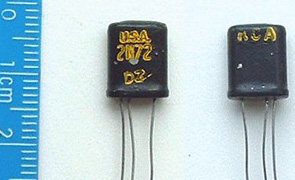
The RCA 2N72 is an extremely rare point-contact transistor that was only produced in limited quantity under a military 'proof of manufacturing' contract. See Jack Ward's site for more details on this device.
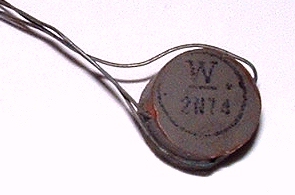
Westinghouse PNP types 2N73 to 2N75 are general-purpose low-frequency switches. I wish to buy examples of these devices.
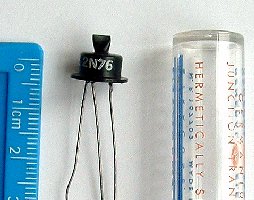
The 2N76 was made by GE, Transitron, and possibly the French company Thomson-Houston. It is a fused-junction PNP AF type with intermediate gain.
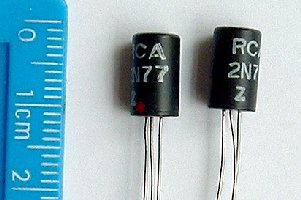
The RCA 2N77 is a PNP alloy-junction type for low-power AF applications 'where extreme stability is paramount'.
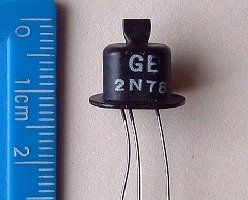
The GE 2N78 was a successful NPN type using a new 'rate-grown' junction technology, and was designed for RF and IF amplification in broadcast receivers. See Jack Ward's site for more details on this device.
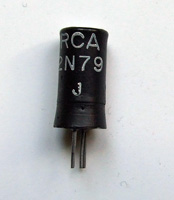
The RCA 2N79 is a PNP general purpose AF amplifier type.
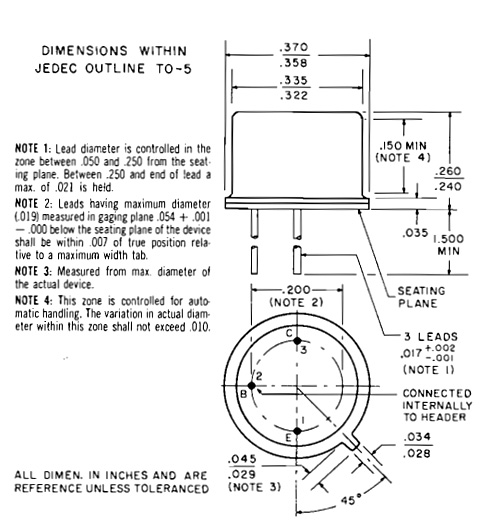
CBS 2N80 and 2N82 are general purpose low-power PNP AF types. The GE Transistor Manual from 1964 shows them in TO-5 cans. I wish to buy examples of these devices.
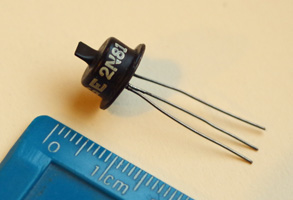
The GE 2N81 is a fused-junction PNP unit particularly recommended for high-gain medium-power applications.
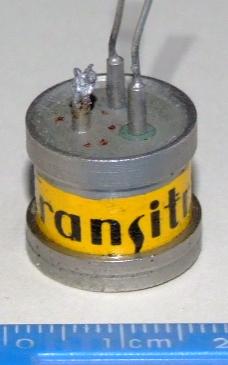
The Transitron 2N83 and 2N84 are medium-power PNP AF amplifier types. There are 'A' suffix versions of both. I wish to buy examples of these devices.
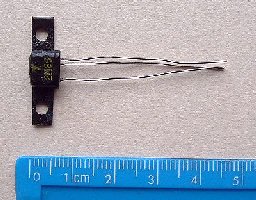
The Transitron 2N85 (shown), 2N86 and 2N87 are PNP medium-power AF amplifier types designed for linear operation over a wide collector current range. They use a TO-22 can with a bar fixed across the back for heat dissipation. I wish to buy examples of the 2N86 and 2N87.
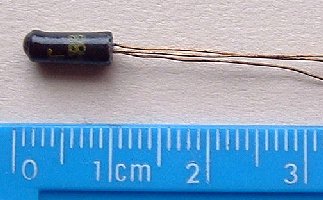
The Transitron 2N88 (shown), 2N89 and 2N90 are PNP low-power AF amplifier types in an unusual small-diameter cylindrical can.
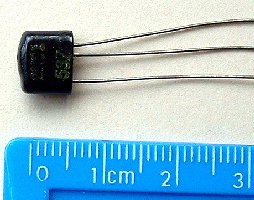
The Transitron 2N91 is a PNP switching transistor designed for use in the range of 100mA collector current.
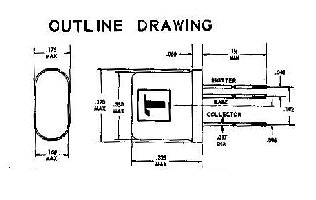
The Transitron 2N92 is a PNP switching transistor designed for use in the range of 5mA collector current. I am seeking examples of this device.
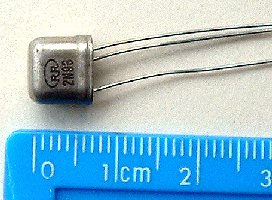
The 2N93 is a low-power PNP AF/IF/switching type from Radio Receptor which was 'carefully selected for reliable performance in airborne communications equipment'.
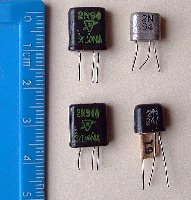
The 2N94 was made by Sylvania for use as an IF amplifier or high-speed switch. Older examples use a large proprietary encapsulation, later ones a more standard TO-22 like can. This device had an 'A' suffix version.
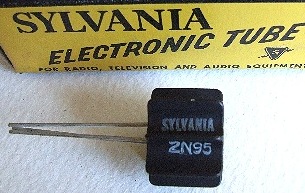
The Sylvania 2N95 is an NPN-alloyed high-current low-voltage type with a large octagonal finned heatsink. See Jack Ward's site for more details on this device.
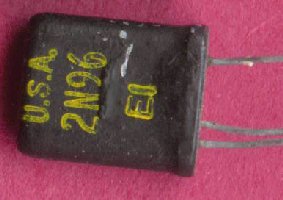
The RCA 2N96 is a very obscure device. It uses the same packaging as the 2N72, and bears the military marking 'USA', suggesting that it too may have been the subject of a proof of manufacturing contract. I wish to buy examples of this device.
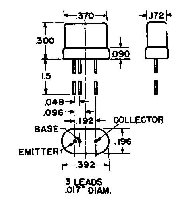
The Germanium Products 2N97 and 2N97A were the first of a family of grown-junction NPN types up to 2N100 with increasing maximum frequency. They also bore Germanium Products RD series type numbers. I wish to buy examples of these devices.
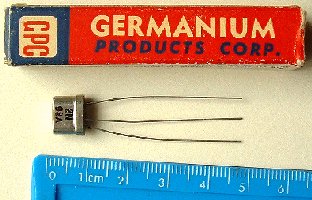
The Germanium Products 2N98 and 2N98A are the second in the family. See Jack Ward's site for more details on this device.
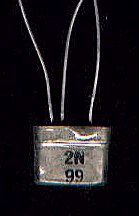
The Germanium Products 2N99 is an NPN switching transistor for computer circuit applications.
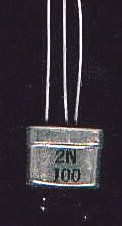
The Germanium Products 2N100 is an NPN switching transistor for computer circuit applications.
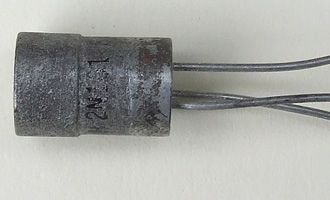
The Sylvania 2N101 is a PNP-alloyed high-current low-voltage type electrically identical to 2N68, but in a different packaging designed to 'render it highly resistant to shock and vibration'. This just means the Sylvania screw-mounted cylinder.
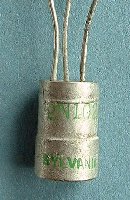
The Sylvania 2N102 is an NPN-alloyed high-current low-voltage type electrically identical to 2N95 but in Sylvania's screw-mounted cylindrical package.
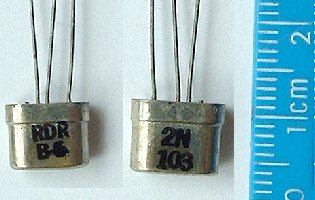
The Germanium Products 2N103 is an NPN grown-junction switching transistor for computer circuit applications.
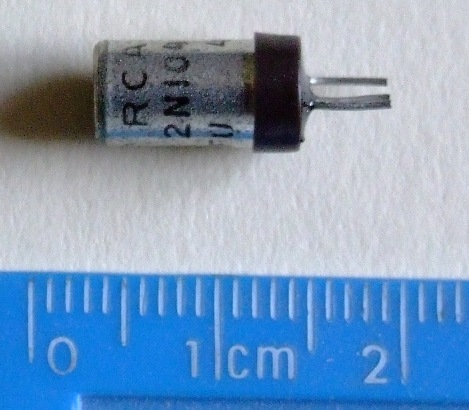
The RCA 2N104 is a PNP-fused transistor also made by Sylvania, for low-power AF amplification.
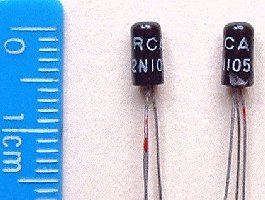
The RCA 2N105 is a sub-miniature low-power PNP AF type especially for use in hearing aids.
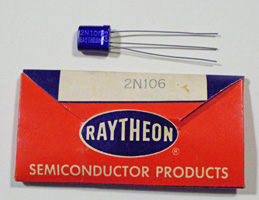
The Raytheon 2N106 is a low-noise PNP AF amplifier transistor in their classic metallic blue oval can.
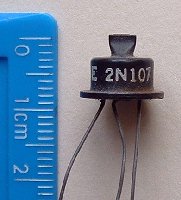
The General Electric 2N107 was introduced as an affordable hobbyist PNP AF device in late 1955. See Jack Ward's site for more details on this device.

The CBS 2N108 is yet another PNP general purpose AF amplifier type. The GE Transistor Manual from 1964 shows it in a TO-5 can. I wish to buy examples of this device.
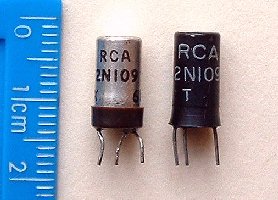
The RCA 2N109 was a very successful commercial PNP AF type. See Jack Ward's site for more details on this device.

The Western Electric 2N110 is an N-type point-contact switching transistor, despite its modern appearance and relatively late 2N number. This transistor is probably the most common point-contact type to be found, presumably Western Electric manufactured many of them for the telephone system.
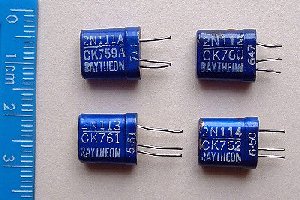
The Raytheon series 2N111 to 2N114 used a tall wide can in classic Raytheon iridescent blue. All were high-frequency devices, 2N111 to 2N113 for IF/RF amplification, 2N114 for use as a converter. Interestingly, they are dual-numbered, with both a standard 2N number and a Raytheon proprietary CK number. Some were made by other manufacturers, e.g. Tung-Sol.
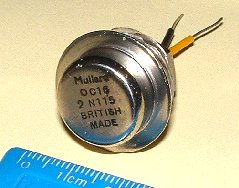
The Amperex 2N115 is a PNP alloy-junction AF power transistor in an unusual package. I wish to buy examples of this device.
My image shows a rare dual-typed transistor made by Mullard of England, marked both 2N115 and OC16
The CBS 2N116 is yet another PNP general purpose AF amplifier type. I wish to buy examples of this device.
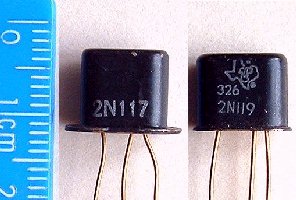
The Texas Instruments NPN types 2N117 to 2N120, introduced in 1956, were the first silicon transistors in the 2N series, and were also the first TI transistors hermetically sealed with a welded enclosure. As well as the standard commercial issue, there are US Navy versions designated USN2N117 etc. They were also made by Transitron.
There does not seem to have been a 2N121. If you know anything about this, please contact me.
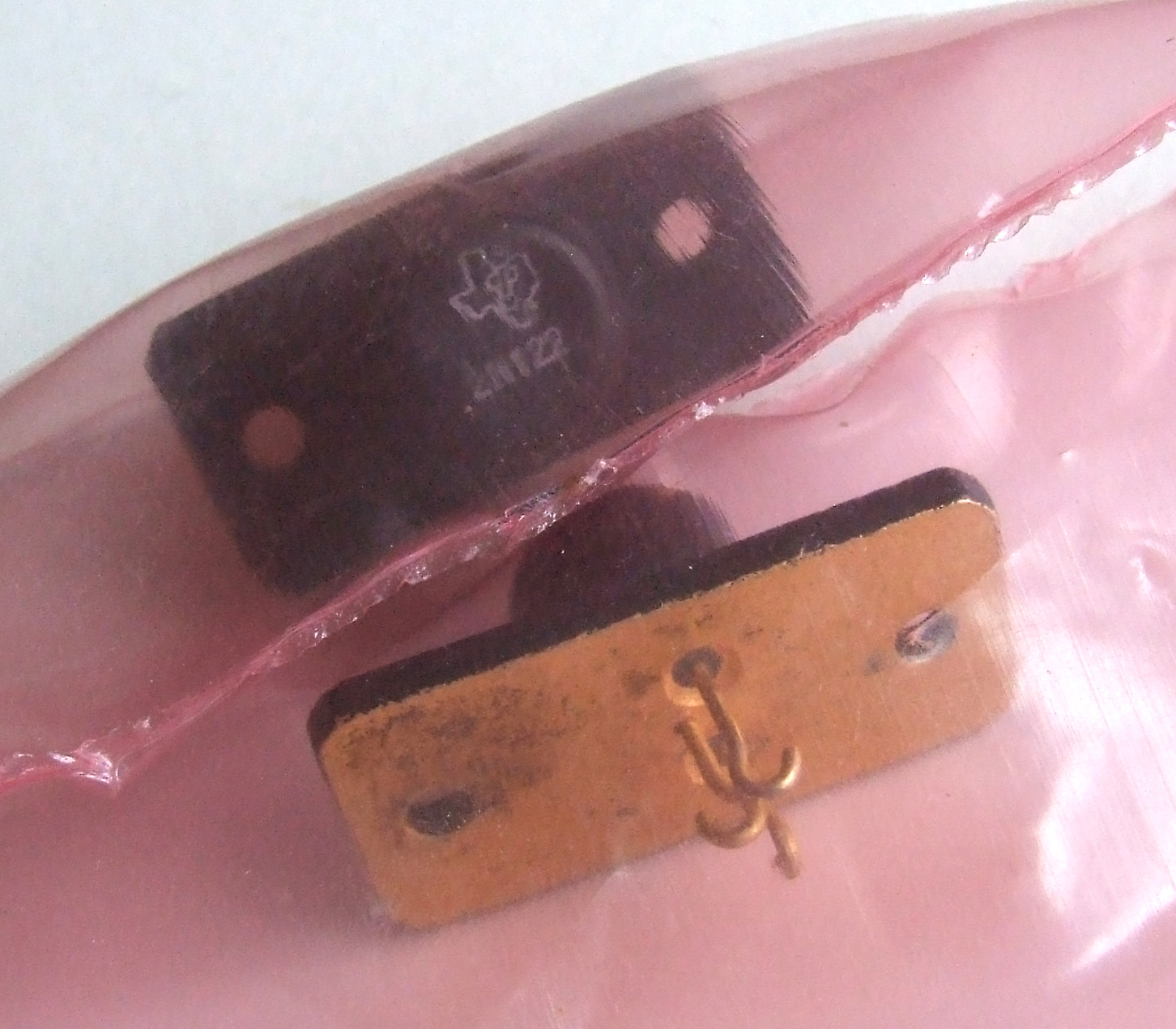
The 2N122 is an unusual silicon power transistor in a unique case. The device was first developed as the experimental type X36, which was renamed as the type 970 with a change of package. The JEDEC registration then assigned it the 2N122 part number. I wish to buy examples of the X36 and 970 devices.
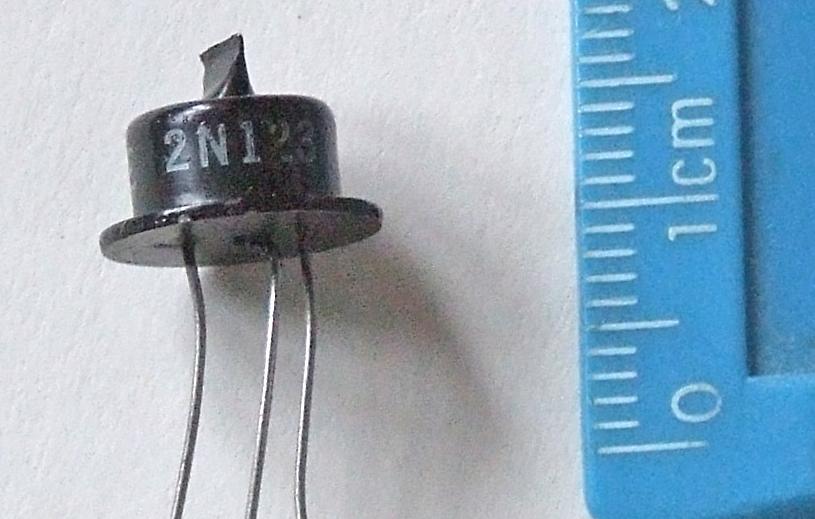
The GE 2N123 is a small black tophat - it is a PNP alloy-junction high-frequency switching type intended for military, industrial and data-processing applications where high reliability at the maximum ratings is of prime importance.
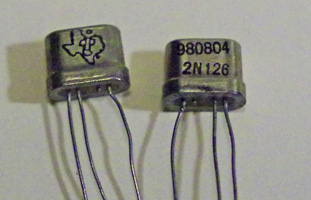
The types 2N124 to 2N127 were made by Texas Instruments. The first edition of the GE Transistor Manual from 1956 lists them as germanium NPN RF/switching transistors, in the TI standard oval encapsulation.
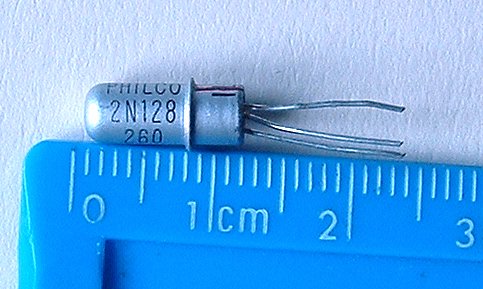
The 2N128 and 2N129 from Philco and Sprague were the first commercial surface-barrier transistors. This was a technology that extended the high-frequency response of the transistor, and it was a major commercial success. See Jack Ward's site for more details on these devices.
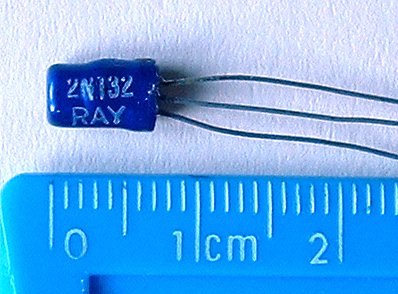
The 2N130 to 2N133 are miniature transistors that were made by Raytheon and painted in their classic iridescent blue colour. They also had Raytheon CK series numbers. I wish to buy examples of the 2N130.
There does not seem to have been a 2N134. If you know anything about this, please contact me.
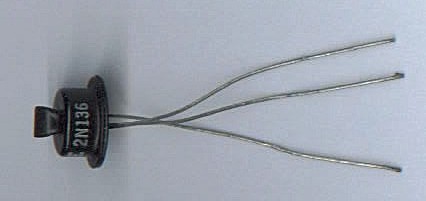
The 2N135 to 2N137 are GE types for use in broadcast receivers. They were made obsolete rather quickly. See Jack Ward's site for more details on these devices.
The 2N138 is a Raytheon transistor. The GE Transistor Manual does not give an outline diagram for it but a Web search shows it was a miniature 'Raytheon blue'.
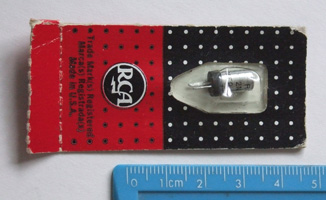
The RCA types 2N139 and 2N140 are PNP types for IF and oscillator circuits respectively.
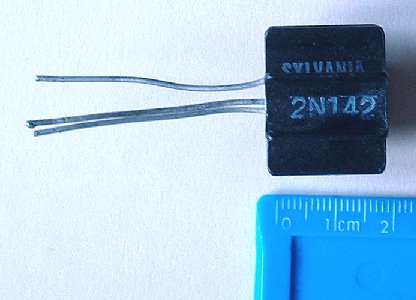
The Sylvania types 2N141 and 2N142 are PNP and NPN high-power types in their large octagonal finned heatsink. They differ from the 2N68 and 2N95 in having slightly greater maximum voltage and current ratings.
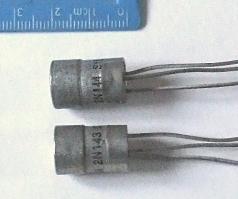
The Sylvania types 2N143 and 2N144 are the same devices as 2N141 and 2N142 without the finned heatsink.
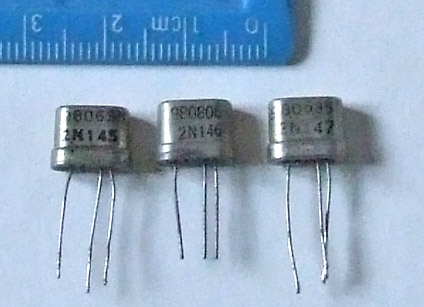
Types 2N145 to 2N150 are NPN IF transistors made by Texas Instruments.
There's a gap in the series with 2N151 to 2N154 missing in the GE data manuals. If you know anything about this, please contact me.
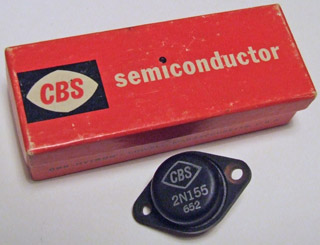
The CBS 2N155 is a PNP power transistor in the TO-3 'diamond' can, the lowest numbered 2N type to use this package, which became ubiquitous for power transistors before plastic encapsulation was invented. 2N157 is missing from the early GE data manuals but is also a black-painted CBS TO-3 power type.
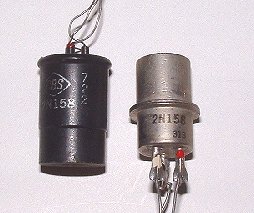
The CBS 2N156 and 2N158 are PNP power transistors in a big cylindrical can with a threaded hole. They were also made by other manufacturers such as Kearfott Semiconductor.
The Sprague 2N159 appears in the General Electric data manuals as a point-contact transistor but no outline drawing is given. If it existed, it possibly used the same 'cigar tube' case as the Philco 2N62. I wish to buy examples of this device.

The types 2N160 to 2N163 were made by Germanium Products in their oval can. If you have any, or know anything about them, please contact me.
The GE types 2N164 to 2N166 are intermediate- and high-frequency transistors intended for use in radio receiver circuits, the last aimed at the amateur/hobbyist market. They probably used TO-5 like cans. I wish to buy examples of these devices.
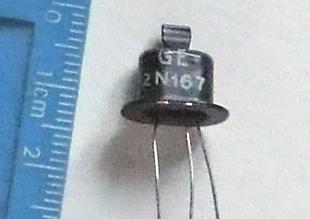
The GE 2N167 is an NPN switching transistor described as for 'military and industrial applictions where reliability is of prime importance'.
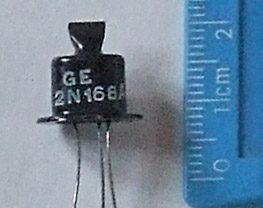
The GE types 2N168 to 2N170 are intermediate- and high-frequency transistors intended for use in radio receiver circuits, the last aimed at the amateur/hobbyist market.
There does not seem to have been a 2N171. If you know anything about this, please contact me.
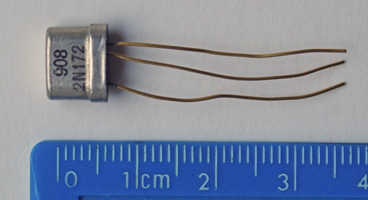
The 2N172 is a Texas Instruments NPN IF type in their standard oval can.
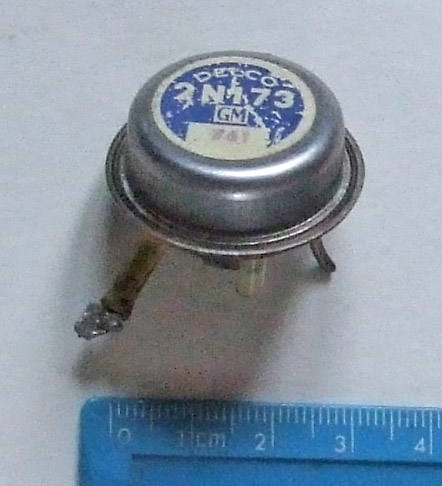
The 2N173 and 2N174 are germanium PNP power types made by Delco from 1956 onwards, for use in car radios. They used the round high-power TO-36 encapsulation. These types were also made by Motorola, RCA and others.
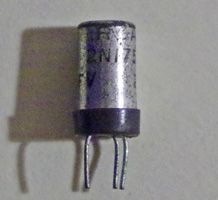
The 2N175 is an RCA PNP AF type listed in the first edition of the GE Transistor Manual from 1956.
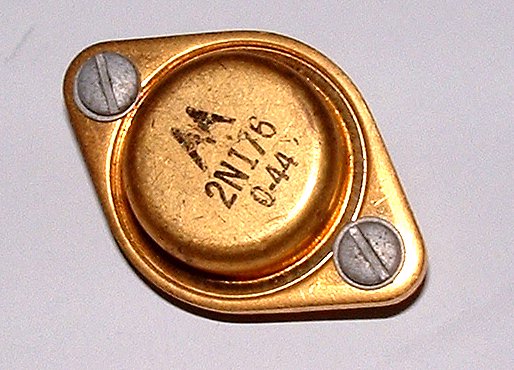
The Motorola 2N176 is their lowest-numbered 2N type and the third-lowest-numbered type in the 2N series to use the TO-3 diamond can. It is a high-power germanium PNP AF type. They also produced 2N178 and 2N179 power types. 2N177 appears to be missing from the series.
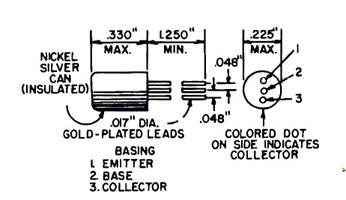
2N180 to 2N184 are CBS types in small TO-1 type cans, the 2N181 with a clip-on heatsink. I am interested in buying these so if you know anything about them, please contact me.
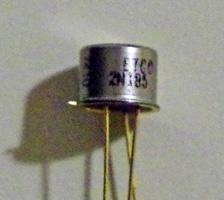
2N185 is a Texas Instruments PNP AF type listed in the first edition of the GE Transistor Manual from 1956 in the standard TI oval encapsulation. My image shows a later TO-5 version by second-source company ETCo (the Electronic Transistor Corporation).
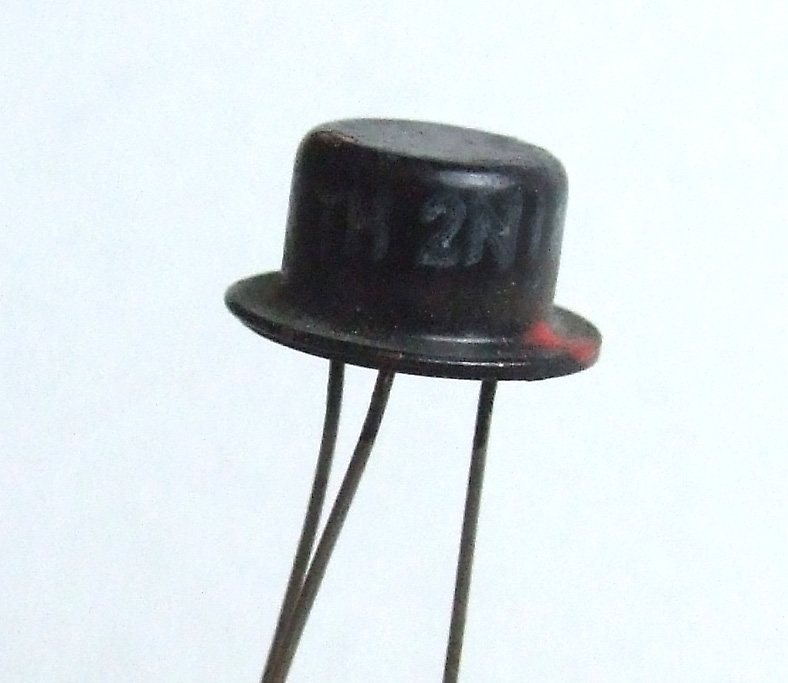
The GE types 2N186 to 2N188 use the small black tophat but are designated as PNP medium-power audio output transistors with a highly linear current gain characteristic.
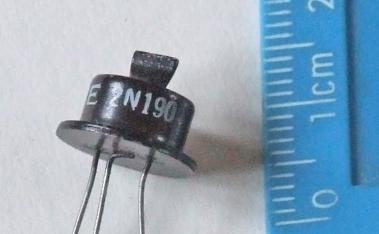
The GE types 2N189 to 2N192, also in the small black tophat, are alloy-junction PNP transistors for use as AF drivers.
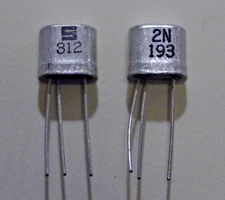
The Sylvania types 2N193 and 2N194 are NPN transistors for use as oscillators. They used the standard small oval encapsulation.
There is a gap in the GE data manuals now to 2N206, and I shall only include a few more interesting higher-numbered types in the series.
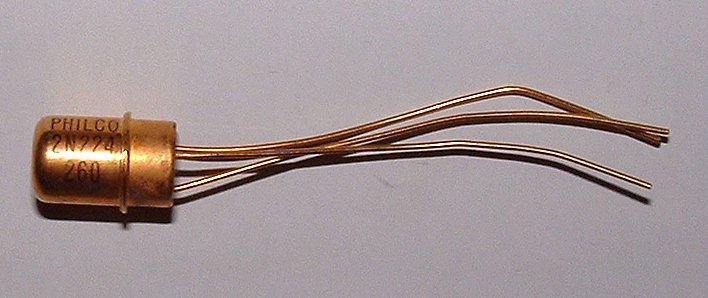
The 2N224 to 2N227 employ a fatter version of Philco's 'cigar tube' package. They are AF output types.
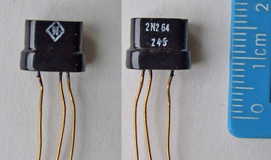
I bought this 2N264 on eBay because the vendor stated that the manufacturer is National Union Electric, who made some very early types shown above. There is a logo of the letter N in a diamond. I'm not sure this really is NUE: if you can provide information, please use the link on the top of this page to contact me. It's a silicon NPN low power general purpose type.
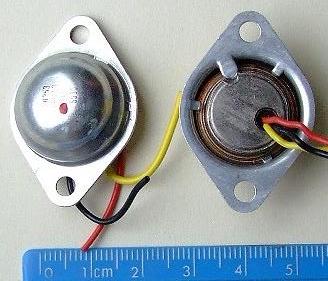
From about 1957, the Philco 2N353 unusually used a TO-27 package inside an aluminium dome.
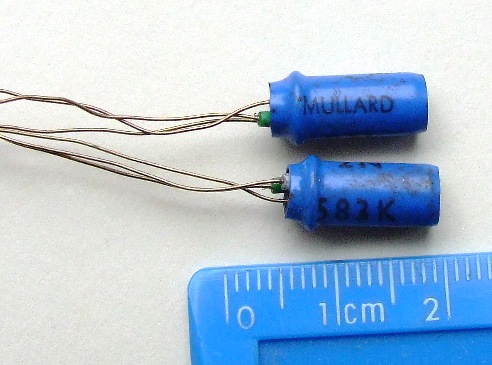
Here's an oddity - type 2N583K, made by Mullard in the UK, using (UK) GEC's non-standard low-power encapsulation.
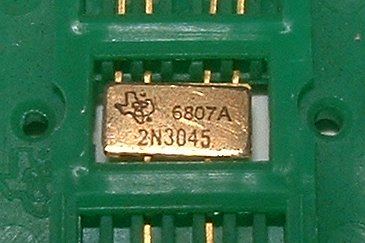
There are higher numbered 2N types that are unusual and interesting. This image shows the extraordinary 2N3045 which is a silicon dual transistor in an IC-style flatpack with only 6 leads used.

